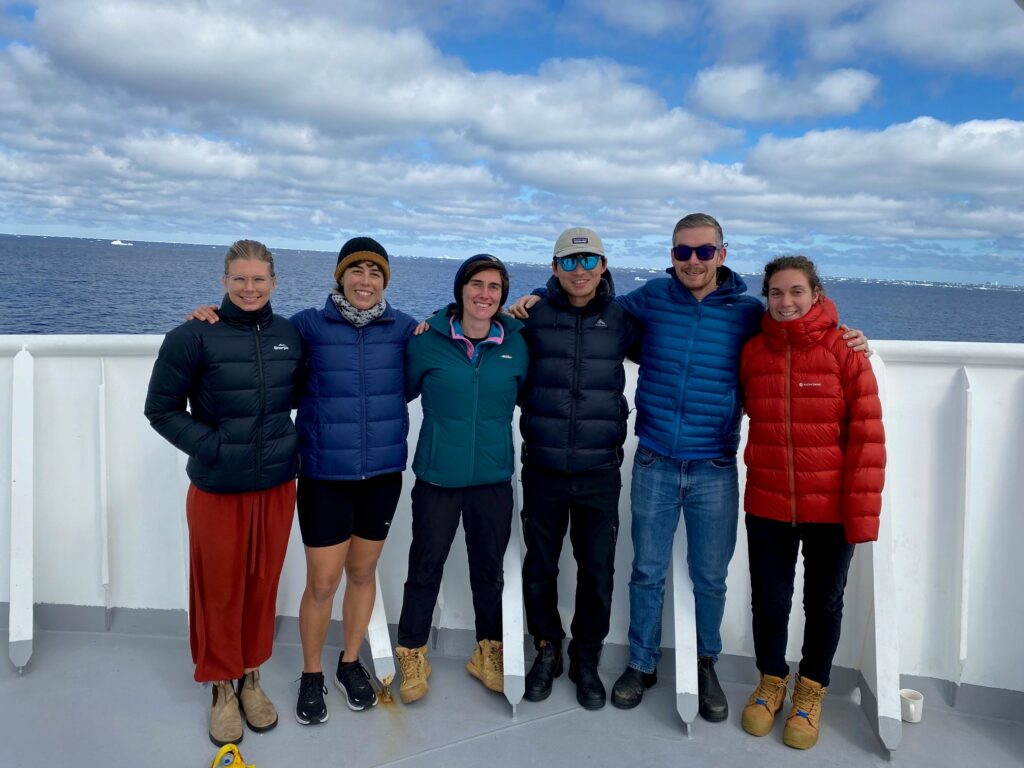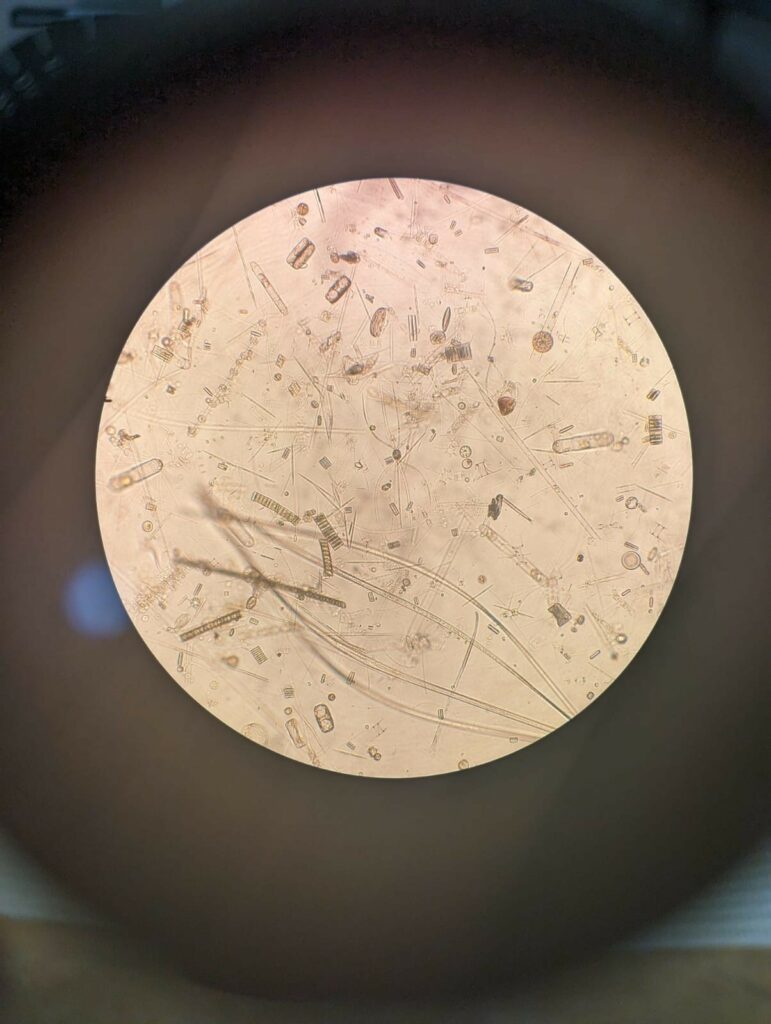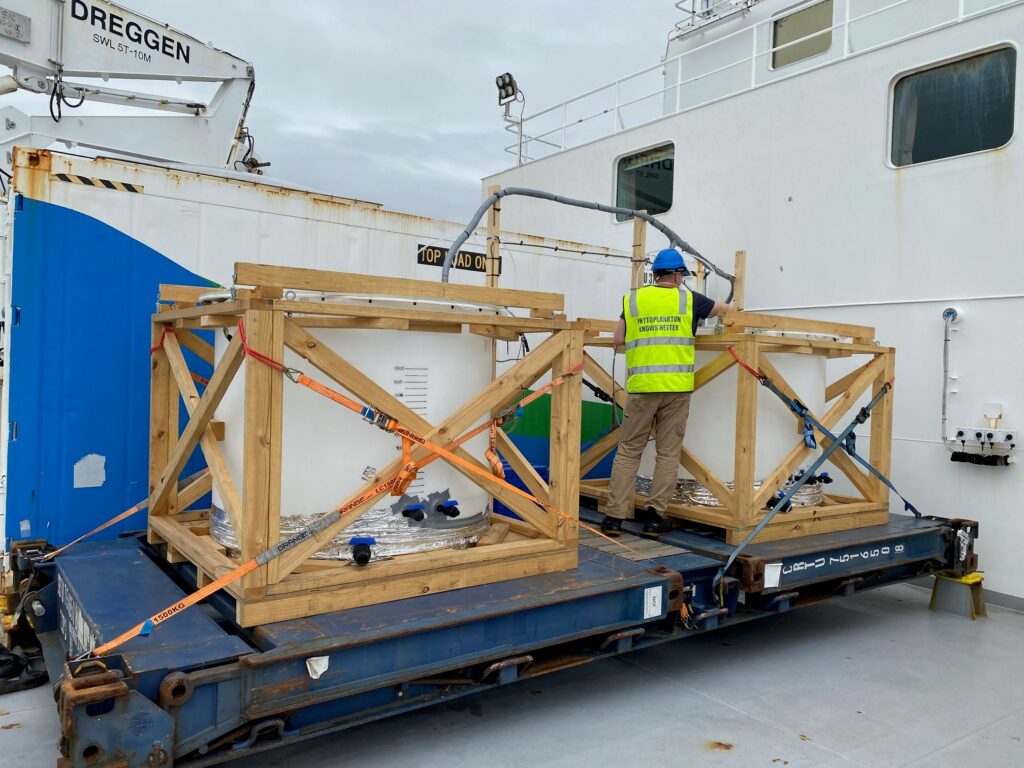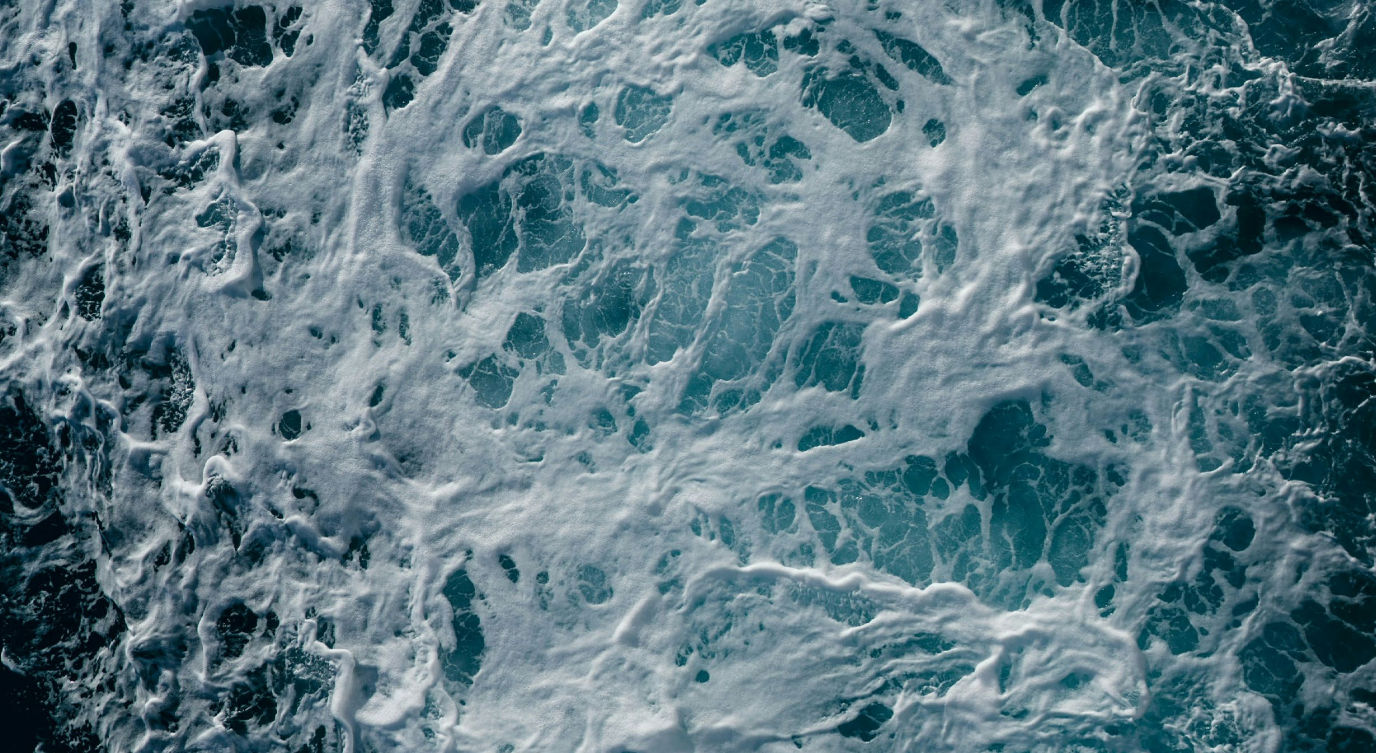News from the Multidisciplinary Investigation of the Southern Ocean (MISO) voyage

The ACEAS team aboard the RV Investigator for the MISO voyage (from left to right: PhD Talitha Nelson, PhD Julia Neme, PhD Anita Butterley, Dr. Kaihe Yamazaki, Dr. Thomas Williams, Dr. Pauline Latour). Image: supplied.
Six ACEAS researchers are currently on 2-month voyage, travelling through the Southern Ocean onboard CSIRO’s RV Investigator. The journey—the Multidisciplinary Investigation of the Southern Ocean (MISO) voyage—is about innovative and collaborative research.
The ACEAS team update us on the voyage so far and the incredible work they’re doing:
We left from Tasmania in early-January and sailed straight south until we hit the Antarctic coastline, before heading west along the Antarctic continental margin. We are currently travelling along the I9S oceanographic line (running along ~112E), all the way from the Antarctic continent to offshore Western Australia. This line is heavily sampled (every half degree of latitude) to get a full picture of the oceanic conditions in this region. I9S is a transect of oceanographic measurements which is repeated every ~10 years, to track changes in ocean conditions. The line has been sampled three times in the past—most recently in 2012—so this check-up is a little overdue! This time around, we have massively expanded the type of measurements being made, which is really exciting, as the data we gather will provide an important baseline for studies in future decades.
MISO brings together a huge range of scientific disciplines, including experts in physical oceanography, biogeochemistry, primary productivity, and atmospheric science. This interdisciplinary focus allows us to unravel the complex interactions occurring within the Southern Ocean. It is rare that a voyage brings together researchers from such a wide range of disciplines, and it has been a fantastic experience working with world-leaders in such a wide variety of fields!
Biological (primary productivity)
Three of us are part of the biological team. During this voyage, we regularly take water samples to study a multitude of parameters informing us on Southern Ocean phytoplankton, the tiny microalgae living in the surface ocean. Just like terrestrial plants, Southern Ocean phytoplankton photosynthesise and in doing so produce oxygen. Additionally, they play a vital role in the transfer of carbon dioxide from the atmosphere into the ocean, a critical process in regulating the Earth climate. Beyond these life-sustaining contributions to our planet, they also form the foundation of numerous marine food webs, sustaining diverse ecosystems throughout the Southern Ocean. Even though they are tiny in size, they have mighty impacts! But despite these essential roles, many unknowns remain surrounding Southern Ocean phytoplankton.

Southern Ocean phytoplankton captured during the MISO voyage. Image: Anita Butterley.
Marine biogeochemistry
Since the 1990s, marine biogeochemistry studies have revealed that growth of Southern Ocean phytoplankton is limited by the low abundance of iron, a critical element for all life on Earth. Despite significant progress in understanding how phytoplankton deal with this shortage, unanswered questions remain, including shifting community composition surrounding iron limitation, the role of ligands (iron-binding molecules which play a key role in sustaining iron in the surface ocean) in altering iron bioavailability, the link between phytoplankton growth and dimethyl sulfide (or DMS, a sulfur compound important for cloud formation), and the interactions between iron and other trace metals, like manganese. To address these questions, we have multiple experiments taking place during MISO, from conventional bottle incubations to larger-scale studies using 2000L tanks. More specifically, we are studying phytoplankton responses to manganese additions, alkalinity enhancement, and changes in iron chemistry.

Dr Robert Strzepek preparing the mescocosms. Image: Pauline Latour.
Another major objective of the voyage is to measure a whole range of biogeochemical parameters on seawater collected along the I9S transect, from the sea surface all the way to the ocean floor. This includes measuring the concentration of dissolved trace metals important for phytoplankton growth, including iron. This work is being carried out in conjunction with the GEOTRACES programme—a global partnership aiming to characterise how ocean chemistry and marine biology interact throughout the global oceans. This voyage is the first to make these kinds of measurements along the I9S line, which is incredibly exciting as we simply don’t know what to expect! Since the Southern Ocean has very low dissolved metal concentrations, precautions need to be made to avoid any contamination which may alter the final results. This includes sampling from a ‘trace metal clean’ instrument and working in a separate self-contained unit on the back deck, known as the Trace Metal Lab, to minimise contact with potential contaminants.

Trace metal container and trace metal rosette with a view. Image: Tom Williams.
Physical oceanography
In collaboration with the biogeochemical measurements, the physical oceanography team, in which two of us are working, collects primary ocean data such as temperature, salinity, dissolved oxygen and current velocity. We operate the CTD (Conductivity-Temperature-Depth profiler) water sampling system, a big metal frame fitted with a number of different instruments and a bottle system that allows us to collect water samples at different depths. The CTD allows us to measure different variables over the whole water column down to more than 4,000 m. Our team uses the water samples collected by the bottles attached to the frame to calibrate our sensors, but we also collect water to measure variables we don’t have sensors for. For example, we are collecting water to measure the stable oxygen isotope ratio (δO18), which can track freshwater originated from Antarctic glacial melting. Other teams’ sample to measure carbon in the ocean, which helps us understand carbon uptake from the atmosphere and changes in the ocean’s pH, nutrient compositions, etc.
Links to global climate
Our team is particularly interested in how climate change has affected the formation of Antarctic bottom water, the densest water mass in the world that fills the global ocean abyss, and how human activity has influenced the Southern Ocean’s service in globally redistributing heat and carbon. Data obtained in this voyage will contribute to our understanding of how the global climate and ecosystem will respond to the human-induced carbon emissions. Just like a blood test for us, ocean measurements can tell us such a variety of information about the Earth’s condition of ‘health’.
Water sampling in the CTD room. Video: Kaihe Yamazaki.
This story is just the tip of the iceberg. For more information about the MISO voyage, check out the AAPP’s MISO blog.


